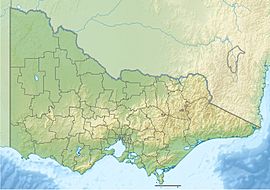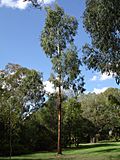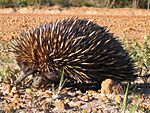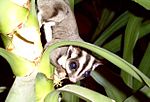Organ Pipes National Park facts for kids
Quick facts for kids Organ Pipes National ParkVictoria |
|
|---|---|
|
IUCN Category III (Natural Monument)
|
|
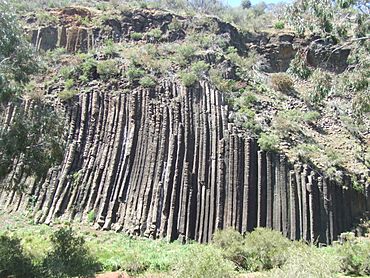
Organ Pipes geological feature.
|
|
| Nearest town or city | Melbourne |
| Established | 12 March 1972 |
| Area | 1.21 km2 (0.5 sq mi) |
| Visitation | 50,000 (in 1996–7) |
| Managing authorities | Parks Victoria |
| Website | Organ Pipes National Park |
| See also | Protected areas of Victoria |
The Organ Pipes National Park (often called OPNP) is a special national park in Victoria, Australia. It's about 121 hectares (about 300 acres) big. This protected area was created to save the native plants and animals. It also protects amazing rock formations along Jacksons Creek, which is part of the Maribyrnong valley. The park is located in a deep gorge within the grassy basalt Keilor Plains, northwest of Melbourne.
Inside Organ Pipes National Park, you can see very old volcanic rocks in the valley walls of Jacksons Creek. These rocks are between 2.5 and 2.8 million years old! They are made of basalt lava that cooled down and cracked into tall, six-sided columns. These columns look like the pipes of a giant organ, which is how the park got its name. Over millions of years, Jacksons Creek slowly carved its way through the land. This cutting action exposed these incredible "organ pipes."
At the very bottom of the Jacksons Creek valley, there's an even older buried creek bed. This ancient valley is cut into 400-million-year-old Silurian mudstones and sandstones. You can even find old creek gravel there. These ancient rocks and the buried valley are hidden beneath the younger volcanic rocks. Marine fossils found in the Silurian rocks show that this area was once covered by a prehistoric ocean!
A group called "Friends of Organ Pipes" (FOOPS) was the first of its kind in Australia. These conservation activists help restore the park's native plants and animals. They work with Parks Victoria, which manages the park. The park is important for teaching people about the geology, plants, and animals of the Keilor Plains. It also shows how damaged land can be brought back to life. The park is recognized internationally by the IUCN as a Category III Natural Monument. This means it's a special place that needs to be protected for its unique natural features.
Contents
Where is Organ Pipes National Park?
The Organ Pipes National Park covers an area of 121 hectares (about 300 acres). It is located about 20 kilometers (12 miles) northwest of Melbourne city. You can reach it easily from the Calder Highway. The park is part of the Victoria Park system.
Jacksons Creek is the main waterway in the park. The city of Hume is to the north of the park, and the city of Brimbank is to the south. Other nearby natural areas include the Holden Flora Reserve, Holden School Site, Derrimut Grassland Reserve, and Laverton and North Grassland Reserve. Most of the park (88.6%) is dedicated to conservation. A smaller part is for recreation and visitors.
Jacksons Creek, along with Deep Creek and Mount Emu Creek, are major branches of the Maribyrnong River. The Maribyrnong River's watershed covers a huge area of 1,300 square kilometers (500 square miles). Jacksons Creek starts in the Wombat State Forest and flows through Gisborne and Sunbury before reaching Organ Pipes National Park.
Weather in the Park
The park is in a "rain shadow" area, meaning it gets less rain. Records from Melbourne Airport since 1972 show that the park gets about 580 millimeters (23 inches) of rain each year. Most of this rain falls during winter and spring. Sometimes, there are very heavy rains. For example, in September 1993, a big flood in the Maribyrnong floodplains damaged plants and destroyed a viewing platform.
History of the Park Area
Early People of the Land
The first people to live in the park area were the Australian Aboriginal Woiworung people. They were part of the Kulin nation, living in the Yarra and Maribyrnong River valleys. Jacksons Creek was a boundary between two of their clan lands. These people were skilled farmers and hunters. They used forest products and harvested native grasses like spear grass. They would burn the grass every year to help it regrow.
The climate and rainfall helped native grasses grow well on the rolling plains. Many animals lived here, including kangaroos, dingoes, bandicoots, gliders, and platypuses. Birds like cockatoos, kookaburras, quails, finches, and hawks were also common. The area was full of lush grasslands and beautiful flowering plants. We know they lived here because archaeologists have found their campsites and tools within the park. The environment along Jackson Creek provided shelter, water, and plenty of food for their settlements.
European Settlers Arrive
In the early 1800s, Europeans from Tasmania began to settle in the area. They brought many new plants and animals with them. They thought the Australian landscape looked dull and had strange animals like kangaroos. So, they introduced plants like boxthorn hedges for fences and trees like oaks, willows, and pines. This made the area look more like their homelands.
Kangaroos were hunted, and rabbits and other furred animals were killed for their valuable skins. This had a very bad effect on the native plants and animals. Soon, "high artichoke thistles covered the creek flats, horehound spread everywhere, boxthorn bushes crowded the slopes, and other weed species filled the gaps. Erosion gullies scarred the steep slopes. Rubbish was piled here and there."
During this time, a small village existed near the Organ Pipes. There was even a suspension bridge across Jacksons Creek to reach a school and farms. The Hall family lived here from 1870 to the 1920s, and some of their plum trees still grow today. You can still find old bluestone walls from the European settlers' time. The stables in the park were built by the Halls. The last owner, E. A. Green, donated his land to the Organ Pipes National Park in 1972.
Becoming a National Park
Because the environment had become so damaged, people who cared about nature decided to help. The National Park Service started this effort in 1972. They declared 65 hectares (about 160 acres) of the donated land as a national park. The goal was to restore the park's ecosystem. This involved planting native seedlings and removing weeds. Now, the original native trees and smaller plants are growing well again.
More land was added to the park in 1978 and 1997. The National Parks Act says that the park's director must "preserve and protect the natural environment of the Park." It also says that the public can use the park for enjoyment, recreation, and education. The park is also known as a "Geological Monument" because of its special rock formations.
The park was chosen because of its interesting geological features. These include the "Organ Pipes" themselves, which are vertical rock structures exposed by the creek's erosion. There's also a tessellated pavement, where the rock surface looks like regular tiles because of how it cracked.
Amazing Rock Formations
The Keilor Plains, where the park's special rock features are found, are part of the larger Western Volcanic Plains. These plains cover much of western Victoria and are the third-largest lava plains in the world! These landforms were created when Jacksons Creek cut into thick lava flows. These lava flows erupted about 2.5 to 2.8 million years ago. The lava sits on top of much older, steeply angled Silurian sedimentary rocks.
Sedimentary rock and fossils in the park are about 400 million years old. This shows that the area was once a sea. The rocks in the park are mostly dark grey or brown. You can find fossils of graptolites (extinct floating animals) and ancient sea snails in these rocks. About 2.5 to 2.8 million years ago, huge lava flows from nearby volcanoes spread across the land.
You can see mudstones and cracked basalt rocks in many places. These include basalt cliffs, piles of boulders, and sedimentary slopes. The park's volcanic features are grouped into the Organ Pipes, Tessellated Pavement, Rosette Rock, and Sandstone layer.
The Organ Pipes
Jacksons Creek has slowly carved a deep valley into the hard, dark basalt rock. This has revealed old volcanic formations like the hexagonal basalt columns known as the "Organ Pipes." The lava deposit in the creek bed is about 70 meters (230 feet) thick. As the lava cooled over many years, the inner molten lava became insulated. This allowed it to form undisturbed columns of basalt.
When the rock cooled, it shrank. This caused tension, and the basalt cracked. It usually cracks in a six-sided pattern, but some columns have up to eight sides. The rock was still very hot (about 400 degrees Celsius or 750 degrees Fahrenheit) when the columns formed. More shrinking happened as the rock lost its remaining heat. This caused horizontal cracks, making some columns look like stacks of cheese.
The rock formation now stands about 20 meters (66 feet) high. It is considered the best example of columnar jointing in Victoria. The unusual shape of the Organ Pipes is due to their rare columnar structure. This happened in a special place where the creek's cutting action created the valley after the volcanic eruptions. The Organ Pipes are named because they look like a pipe organ. Each pipe in the formation is about 1 meter (3 feet) wide. Some columns are vertical, while others around them are tilted or horizontal.
Tessellated Pavement
The Tessellated Pavement is a collection of basalt columns that look like a tiled floor. It formed because of erosion by Jacksons Creek. You can see it about 250 meters (820 feet) upstream from the Rosette Rock. It's important to be careful when visiting this formation to help protect it.
Rosette Rock
The Rosette Rock is a basalt outcrop with columns arranged like the spokes of a giant wheel. It's about 500 meters (1,640 feet) upstream from the Organ Pipes. This overhanging rock is on the northern bank of the stream. It formed when a pocket of lava cooled, probably inside a spherical cave from an earlier lava flow.
Sandstone Layer
The sandstone layer in Jackson Creek is about 400 million years old. It's made of quartz and quartzite gravel. You can find it halfway between the car park and the Organ Pipes. This layer is part of an ancient stream bed that was buried by a lava flow. Jacksons Creek later cut through the lava, revealing it. Similar "deep leads" were mined for gold in Ballarat during the Gold Rushes.
Plants of the Park
When the park was created in 1972, much of the area was degraded and full of weeds like thistles and boxthorns. Since then, a lot of work has been done to remove introduced plants and pests. The goal is to bring back the natural vegetation and wildlife. By 2002, large areas of trees and shrubs were re-established. Systematic planting of native grasses, plants, and trees began, creating big areas of kangaroo grass. This re-vegetation project, ongoing for over two decades, has created many different ecosystems. You can now see seven types of wattle blooming at once, along with many other native plants.
Thanks to the re-vegetation program, 124 native plant species have been identified in the park. More than 20 of these are rare, threatened, or important. Some of the important grassland plants that have been brought back include:
- Chloris truncata (windmill grass)
- Bothriochloa macra (redleg grass)
- Danthonia species (wallaby grasses)
- Dicanthium sericeum (silky bluegrass)
- Themeda triandra (kangaroo grass)
- Rutidosis leptorrhynchoides (button wrinklewort, an endangered species)
- Callitris glaucophylla (white cypress-pine)
Along the banks of Jacksons Creek, you can find remaining native plants. These include river red gum woodlands, manna gum, and blackwood. There are also reed beds, sedgelands, shrubs, and grasslands. The Callitris glaucophylla population here is one of only two found near Melbourne.
While the growth of natural vegetation is great, it sometimes makes it harder to see the geological formations.
Animals of the Park
Organ Pipes National Park is home to many different animals. You can find them in the creek areas, on the slopes, and in the grasslands. The animals in the OPNP include:
- Mammals: eastern grey kangaroo, swamp wallaby, and echidnas. Bat species are also very diverse. A successful project to provide bat roosting boxes has been going on for twenty years.
- Birds: Many bird species are increasing, including the wedge-tailed eagle.
- Reptiles: Long-necked tortoises, the eastern bearded dragon, and the red-bellied black snake.
- Amphibians: The Growling grass frog has reappeared.
- Fish: Many native fish species, like the mountain galaxias, have also returned.
In 1989, sugar gliders (Petaurus breviceps) were brought back to the park from Toolern Vale. They had been seen in the OPNP in 1916 but then disappeared. This is one of many projects run by the Friends of the Organ Pipes National Park. Overall, the park authorities have reported 15 native mammal species, 88 bird species, 13 reptile species, and six amphibian species.
How the Park is Managed
A Management Plan was approved in 1996 to help run the park. The main goals are to protect nature and let the public learn about the park's natural and cultural heritage. It also aims to encourage tourism. The park is divided into different zones, each with specific actions to manage it. This helps make sure everything works together and progress can be checked regularly.
Over the years, many management actions have been taken to change the park from a degraded area to a nearly natural ecosystem. These include:
- Controlling weeds using machines, chemicals, and sometimes fire.
- Removing harmful weeds and pests like rabbits.
- Restoring damaged land through a big re-vegetation program.
- Controlling erosion.
- Maintaining seed banks and nurseries for native plants.
There is an Information Center in the park. It provides details about the park's volcanic formations, the Aboriginal people who lived there, and early European settlements. It also shares information about the re-vegetation project and the park's important role in protecting the local environment.
Things to See and Do
The Organ Pipes National Park is a popular place to visit. Its main attractions are the Organ Pipes, the Tessellated Pavement, and the Rosette Rock. There is a Visitors Center and a picnic area next to the car park. Short walking tracks lead down a steep hill to Jacksons Creek and the amazing rock features.
The park is located under the flight path of Melbourne Airport and next to the Calder Park Raceway. So, you might hear aircraft or motor sport noise during your visit. However, the birds and other animals don't seem bothered by it. If you visit early in the morning or at dusk, you might be lucky enough to see swamp wallabies and eastern grey kangaroos.
See also
 In Spanish: Parque nacional Tubos de Órgano para niños
In Spanish: Parque nacional Tubos de Órgano para niños


